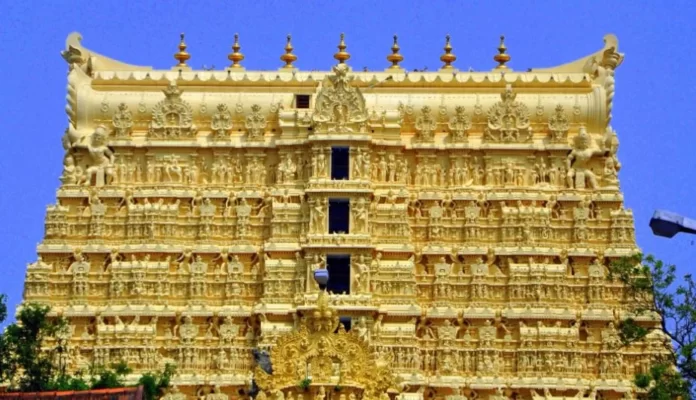Sree Padmanabhaswamy Temple is an ancient Hindu temple dedicated to Lord Padmanabha (a form of Lord Vishnu). Here are 18 interesting Facts About Padmanabhaswamy Temple.
Padmanabhaswamy Temple is located in Thiruvananthapuram (formerly known as Trivandrum), the capital city of Kerala, India. It is renowned for its architectural splendor, spiritual significance, and the incredible wealth discovered within its vaults.
What sets the Padmanabhaswamy Temple apart is the discovery of immense treasures within its vaults, estimated to be one of the richest collections in the world. The treasures include gold idols, jewelry, precious stones, and ancient artifacts.
Facts About Padmanabhaswamy Temple
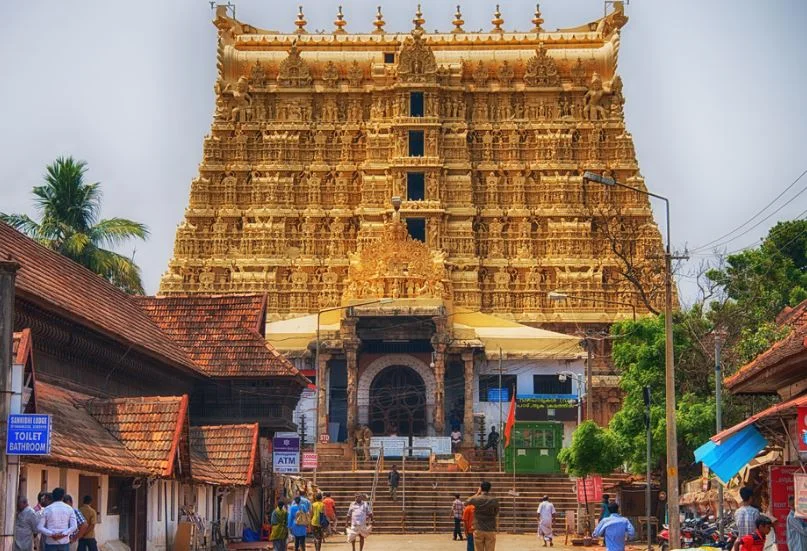
Here are 18 interesting Facts about Padmanabhaswamy Temple.
1. Historical Facts about Padmanabhaswamy Temple
The temple is believed to have been constructed in the 8th century AD and is an excellent example of the Dravidian style of architecture. The deity of Lord Padmanabha reclines on the sacred serpent Ananta (Sheshnag) within the inner sanctum of the temple.
- Padmanabhaswamy Temple, located in Thiruvananthapuram, Kerala, India, is one of the most ancient and revered temples in the country.
- The temple is dedicated to Lord Padmanabha, a form of Lord Vishnu, and is believed to have been built in the 8th century AD.
- It is considered one of the 108 Divya Desams, holy abodes of Lord Vishnu mentioned in ancient Hindu scriptures.
- The temple holds immense religious and cultural significance and is an important pilgrimage site for devotees of Lord Vishnu.
2. Architectural Facts about Padmanabhaswamy Temple
- Padmanabhaswamy Temple showcases the Dravidian style of architecture, characterized by intricate carvings and exquisite craftsmanship.
- The temple’s towering gopuram (gateway tower) stands at a height of over 100 feet and is adorned with detailed sculptures and ornate decorations.
- The temple complex consists of multiple mandapams (halls), corridors, and sanctums, displaying the grandeur and opulence of the architectural style.
- The temple’s architectural beauty is a testament to the rich cultural heritage of the region and attracts tourists and art enthusiasts from around the world.
3. Hidden Treasures
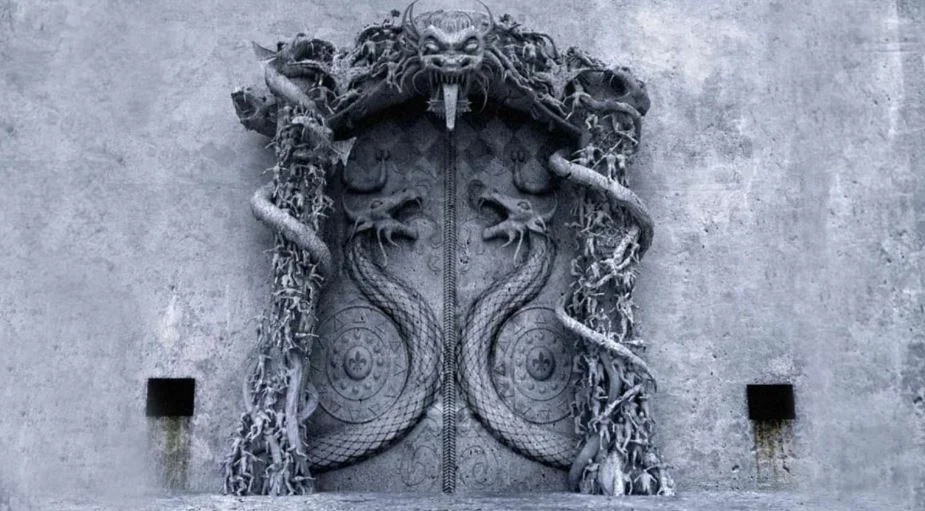
- Padmanabhaswamy Temple gained international attention for the discovery of hidden treasures within its vaults.
- In 2011, six vaults within the temple were opened, revealing an astonishing collection of gold ornaments, jewels, precious stones, and antique artifacts.
- The estimated value of the treasures is believed to be billions of dollars, making it one of the richest temples in the world.
- The discovery of the treasures brought the temple into the global spotlight and raised curiosity about its historical and cultural significance.
- The treasures are securely protected and have become an integral part of the temple’s legacy and heritage.
4. Ananthasayanam Vishnu Idol
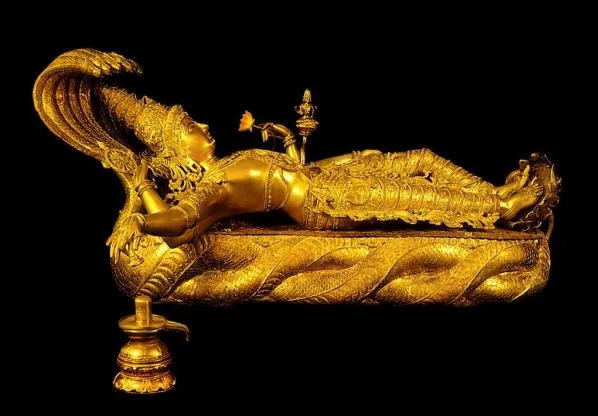
The main deity of Padmanabhaswamy Temple is Lord Padmanabha, reclining on the sacred serpent Anantha (Adi Sesha).
- The idol of Lord Padmanabha is carved out of a unique combination of Katusarkara Yogam (a mix of rare herbs and minerals).
- The idol, in a reclining posture with Lord Brahma emerging from Lord Vishnu’s navel, is an awe-inspiring sight for devotees.
- The idol is approximately 18 feet long and can be viewed through three different doors, symbolizing the Trimurti (Brahma, Vishnu, and Shiva).
- The deity’s majestic presence evokes a sense of divinity and devotion among the devotees.
5. Mural Paintings Facts about Padmanabhaswamy Temple
The walls of Padmanabhaswamy Temple are adorned with exquisite mural paintings that depict mythological stories and celestial beings.
- The paintings, executed in vibrant colors, showcase the artistic brilliance of the bygone era.
- The themes of the murals include episodes from the Mahabharata, Ramayana, and various incarnations of Lord Vishnu.
- These intricate and detailed paintings not only add to the temple’s aesthetic appeal but also serve as visual narratives of Hindu mythology.
- The preservation and restoration of these mural paintings are undertaken to maintain their historical and artistic value.
6. Navagraha Temples
Padmanabhaswamy Temple complex houses separate shrines dedicated to the Navagrahas, the nine celestial deities representing the planets.
- Each shrine is dedicated to a specific planet and is believed to bring blessings and alleviate planetary afflictions.
- Devotees visit these shrines to seek the appeasement of the respective planets and ensure their planetary well-being.
- The Navagraha Temples within the complex further enhance the spiritual significance of the temple and provide comprehensive religious services.
7. Festivals Facts about Padmanabhaswamy Temple
- Padmanabhaswamy Temple follows a rich tradition of rituals and celebrates various festivals throughout the year.
- The daily rituals include multiple poojas, abhishekams, and Deeparadhana (lamp lighting) performed by a team of dedicated priests.
- The temple observes major festivals like Janmashtami (Lord Krishna’s birth), Vishu, and Thiruvonam with great devotion and grandeur.
- The annual festival of Alpashy Utsavam, also known as Navaratri festival, is celebrated with religious fervor and attracts a large number of devotees.
- During the festivals, the temple is adorned with colorful decorations, and elaborate processions and cultural performances take place.
8. Non-Hindu Devotees
- Unlike many other Hindu temples, Padmanabhaswamy Temple allows non-Hindu devotees to visit and explore its architectural beauty.
- The temple’s management believes in promoting cultural and religious harmony by welcoming people from all faiths.
- Non-Hindu visitors are restricted from entering the inner sanctum where the main deity resides but are allowed to witness the temple’s splendor.
9. Temple Tank
- Padmanabhaswamy Temple features a sacred temple tank known as Padma Theertham or Padma Pushkarini.
- The tank is believed to be connected to the ancient Padmatheertham Tank in Vaikunta, Lord Vishnu’s celestial abode.
- Devotees take a holy dip in the tank before entering the temple, considering it as a purifying ritual.
- The tank’s serene ambiance and the belief in its divine origin contribute to the spiritual aura of the temple complex.
10. Strict Dress Code

Padmanabhaswamy Temple has a strict dress code for both men and women to maintain the sanctity and decorum of the holy place.
- Men are required to wear traditional attire such as dhoti (mundu) without a shirt or upper garment.
- Women are expected to wear traditional sarees or salwar kameez with a dupatta.
- Devotees who do not adhere to the dress code can rent or purchase the appropriate attire from shops near the temple.
- The dress code is enforced to ensure a respectful and uniform atmosphere for all visitors.
11. Ananda Nidra Facts about Padmanabhaswamy Temple
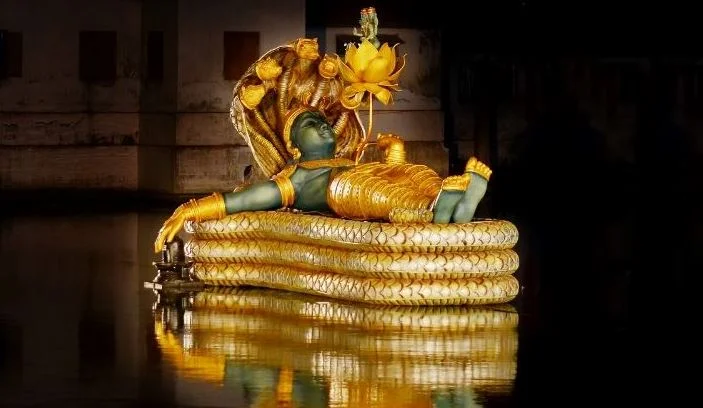
The deity of Lord Padmanabha is believed to be in a state of eternal cosmic sleep called Ananda Nidra.
- It is believed that Lord Vishnu, in the form of Padmanabha, is resting and maintaining the cosmic balance within the universe.
- The Ananda Nidra posture represents the divine tranquility and cosmic harmony associated with Lord Vishnu.
- The state of Ananda Nidra adds to the spiritual significance of the temple and the divine presence of Lord Padmanabha.
12. Rituals for Devaswom Elephant
Padmanabhaswamy Temple is known for its association with an elephant named Guruvayur Kesavan, who is considered the Devaswom elephant.
- The temple follows specific rituals and traditions for the well-being and care of the Devaswom elephant.
- The elephant participates in temple processions, ceremonies, and rituals, adding an element of grandeur to the temple’s festivities.
- Devotees have a deep reverence for Guruvayur Kesavan and believe that offering prayers to the elephant brings blessings from Lord Padmanabha.
13. Music and Dance Tradition
Padmanabhaswamy Temple has a rich tradition of music and dance, with regular performances of classical music and dance forms.
- The temple promotes the cultural heritage of Kerala by organizing concerts, recitals, and dance performances within its premises.
- Renowned musicians and artists from across the country perform here, adding a cultural dimension to the temple’s ambiance.
The temple’s association with the performing arts further highlights its role as a center for spiritual and cultural enrichment.
14. Temple Library
- Padmanabhaswamy Temple houses a well-maintained library that preserves and protects ancient manuscripts, palm-leaf scriptures, and rare texts.
- The library is a repository of knowledge, covering a wide range of subjects including philosophy, astrology, music, and literature.
- Scholars and researchers visit the library to study and explore ancient texts and gain insights into the region’s intellectual heritage.
- The temple library’s collection is a testament to the preservation of traditional knowledge and the temple’s commitment to intellectual pursuits.
15. Gopuram Height Restriction
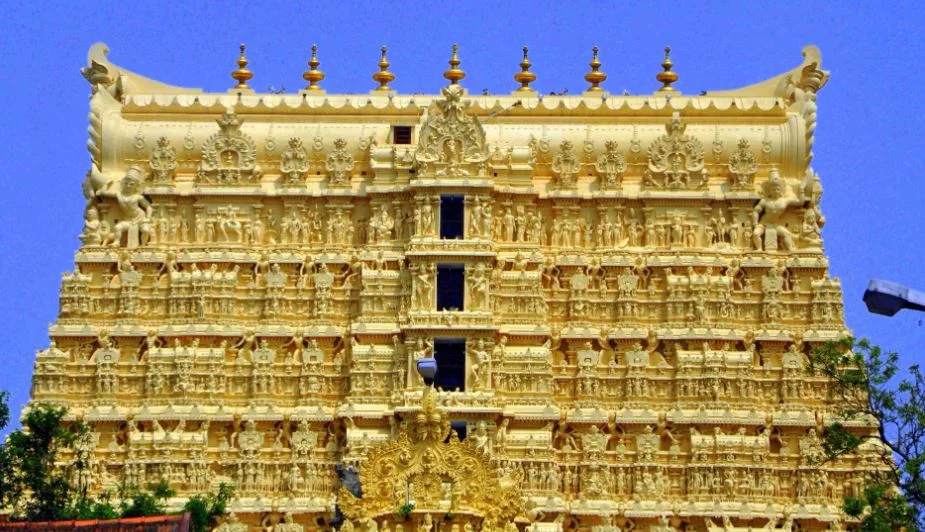
The gopuram (gateway tower) of Padmanabhaswamy Temple has a unique feature where its height is limited.
- According to local beliefs, the height of the gopuram should not exceed the height of the nearby Sreevaraham Temple’s flagpole.
- This restriction symbolizes the reverence and respect given to the Sreevaraham Temple, which is considered the ancestral temple of Padmanabhaswamy Temple.
- The adherence to this tradition reflects the harmonious coexistence and mutual respect among different temples in the region.
16. Temple Administration
The administration of Padmanabhaswamy Temple is carried out by a trust called the Travancore Royal Family, which has been overseeing the temple’s affairs for centuries.
- The trust is responsible for managing the temple’s properties, rituals, festivals, and daily operations.
- The trust also plays a significant role in preserving the temple’s cultural heritage and implementing initiatives for the welfare of devotees and the local community.
17. Temple Kitchen and Annadanam
Padmanabhaswamy Temple operates a massive kitchen that prepares meals for devotees as part of the Annadanam (food donation) program.
- The temple follows the tradition of offering free meals to devotees, regardless of their caste, creed, or social status.
- The Annadanam program serves thousands of devotees every day, ensuring that no one goes hungry in the vicinity of the temple.
The temple’s commitment to providing food and nourishment exemplifies the ideals of compassion, service, and inclusivity.
18. Devotee Services
- Padmanabhaswamy Temple strives to provide a comfortable and convenient experience for devotees by offering various amenities and services.
- The temple premises include facilities such as restrooms, drinking water, and resting areas for devotees.
- Additionally, the temple has arrangements for the distribution of prasadam (consecrated food) to devotees as a blessed offering.
- The temple management emphasizes the importance of providing a hospitable environment, ensuring that devotees can have a fulfilling and peaceful visit.
How to Reach Padmanabhaswamy Temple?
Padmanabhaswamy Temple located in Thiruvananthapuram, the capital city of Kerala, makes it easily accessible for visitors. The temple complex covers a vast area and features intricate carvings, mural paintings, and a serene pond called Padma Theertham.
Padmanabhaswamy Temple is a revered pilgrimage site that attracts devotees from all over the world. It holds great religious and cultural significance for the people of Kerala.
Related Posts
- 21 Facts About Vaishno Devi
- 19 Facts About Amarnath
- 21 Facts About Kedarnath
- 27 Facts About Badrinath
- 16 Facts About Gangotri
- 17 Facts About Yamunotri
